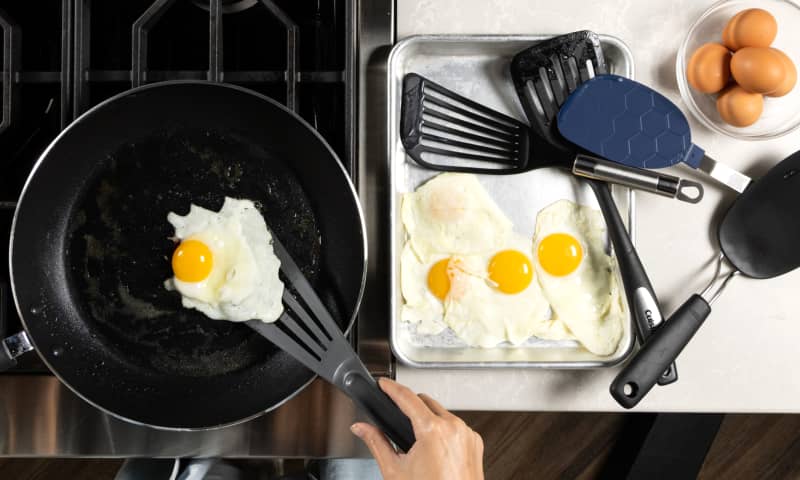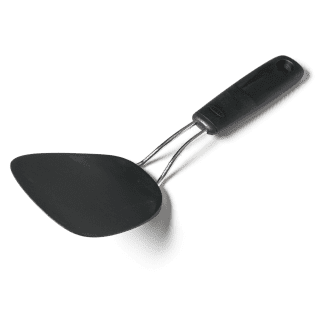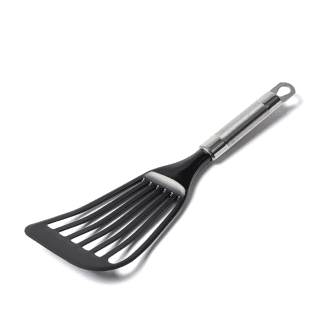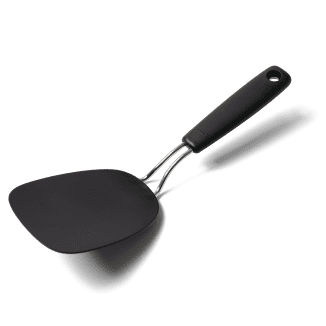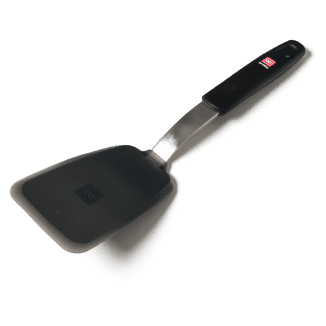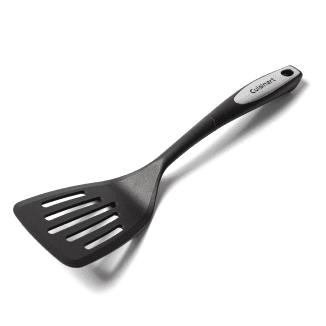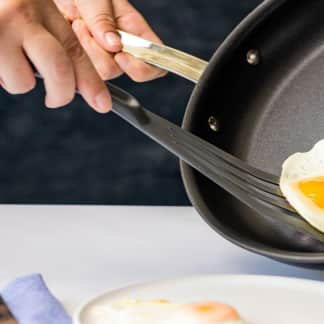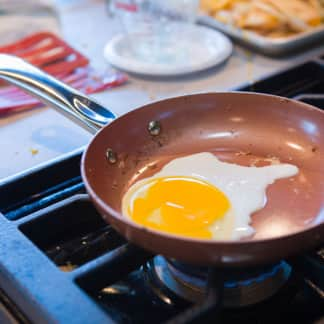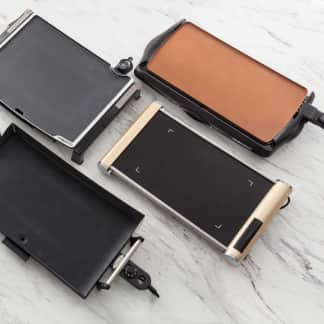The best nonstick-safe spatulas are comfortable to hold and lightweight enough to maneuver nimbly, with thin edges that slide easily under foods of all shapes and sizes. They should be sturdy enough to support heftier foods without bending and sufficiently durable to endure long-term use over hot stoves. Our winner, the Matfer Bourgeat Exoglass Pelton Spatula, checked all of these boxes, feeling like a natural extension of our hands.
Not the type of spatula you were looking for? Check out our metal spatula review, our compact spatula review, our grill spatula review, our silicone spatula review, our jar spatula review, our offset spatula review, our mini offset spatula review, or our offset turner review. (Yes, we know spatulas.)

Metal spatulas are great for flipping food in—or transferring food from—metal cookware and bakeware. But when we’re using nonstick cookware, we prefer to use spatulas with heads (flat surfaces) made from nylon, silicone, or other nonmetal materials. That’s because they’re gentler and less likely to scratch nonstick surfaces. We tested several nonmetal spatulas in a wide array of shapes, sizes, and materials, including nylon, resin/fiberglass composite, and silicone. We noted how easy they were to use and how durable and sturdy they were while flipping and transferring eggs, pancakes, salmon steaks, sole fillets, and veggie burgers in a variety of nonstick cookware.
What to Look For
- Thin Heads: We prefer models with thin heads measuring from 1.3 to 1.8 millimeters at their thickest. These slide easily under eggs, pancakes, and delicate sole fillets without pushing them around or damaging them.


Thin heads (left) got up and under food much more easily and cleanly than thick heads (right), which often squashed or marred delicate foods.
- Nylon or Resin/Fiberglass Composite: Spatula heads made from nylon and resin/fiberglass are almost always thinner and more flexible than silicone heads. Nylon and fiberglass/resin heads were also smoother and less grippy than silicone heads, allowing them to slide under foods much more easily.
- Spacious Heads: In general, we prefer models with heads that have a good amount of surface area, because they are better able to handle foods of different sizes and weights. A spatula head with a surface area of 12 to 15 square inches proved ideal; smaller heads couldn’t support large salmon steaks, and bigger heads felt awkward and clumsy in the 8-inch skillets we used to make eggs over easy.
- Traditional Fish Spatula Shapes: Most testers had a slight preference for heads that were fairly long and tapered toward the handle—the shape of a traditional metal fish spatula. Spatulas with heads of this shape navigated smaller spaces more nimbly and provided a landing strip for food to travel along; pancakes and fish fillets didn’t fall off or get squashed when we needed to use a little force to get the spatula under the food.

- Moderately Long, Straight Handles: We preferred handles of moderate length—4.75 to 5.5 inches was ideal—that gave large hands plenty of room to hold on and positioned hands of all sizes close enough to the food to ensure good control. Handles that stuck straight out from the head felt more like extensions of our arms than those that were offset, allowing us to maneuver and flip foods with ease.

What to Avoid
- Thick or Steeply Beveled Heads: Models with thicker heads struggled to slip under foods such as pancakes or veggie burgers, often either pushing them around or damaging them. Some spatulas had heads that were steeply beveled, with a front edge that was thinner than the rest of the head. While this beveled edge did help us to get the head under the food initially, we still had to push the rest of the thick head under the food, sometimes squashing or denting it in the process.

Spatulas made from nylon (pictured) are prone to melting and burning at slightly lower temperatures than those made from silicone. Don’t leave any part of a nylon spatula on a hot pan.
- Silicone: Silicone alone is too soft and floppy to support food, so manufacturers reinforce silicone spatula heads with metal or fiberglass frames. These frames made the silicone models substantially thicker and more rigid than their nonsilicone counterparts. Silicone heads measured between 2.5 and 7 millimeters at their thickest and couldn’t hug the cooking surface quite as closely as nylon or resin/fiberglass heads. However, silicone does have one advantage: It can withstand much higher temperatures than nylon or fiberglass/resin. The silicone models we tested all withstood temperatures up to 600 degrees without melting or warping, whereas the nylon and resin composite spatulas all began to melt when left in a pan heated to between 400 and 500 degrees. Still, performance trumped durability for our testers, who universally agreed that they’d rather be more careful with a thin nylon spatula than fight to remove food with a clumsily thick but more heat-resistant silicone spatula.

Spatulas made from nylon or resin/fiberglass (top) were much thinner than those made with metal frames surrounded by silicone (bottom).
- Oversized or Undersized Heads: Heads with surface areas smaller than 12 square inches couldn’t support large salmon steaks, and bigger heads (more than 15 square inches) felt awkward and clumsy in the 8-inch skillets we used to make eggs over easy.
- Long or Short Handles: Handles shorter than about 4.5 inches were generally too small for large hands, whereas longer handles (more than about 5.5 inches long) usually put our hands too far from the food.
- Angled Handles: Handles that were offset from the heads positioned our arms in awkward angles when reaching into skillets to flip food. We found that the more pronounced the handle angle, the more cumbersome the spatula was to use.
The Tests
- Flip and transfer eggs over easy
- Flip and transfer pancakes
- Flip and transfer sole fillets
- Flip and transfer Vegan Pinto Bean-Beet Burgers
- Have five users of different dominant hands and hand sizes try
- Wash by hand or in the dishwasher 25 times
How We Rated
- Durability: We evaluated how well the spatulas withstood damage from heat and general use.
- Ease of Use: We evaluated how nimbly the spatulas maneuvered around nonstick cookware of different sizes and shapes, how comfortable they were to hold, and how much control they gave us.
- Performance: We evaluated how well the spatulas flipped foods in—and removed foods from—a variety of nonstick cookware.
